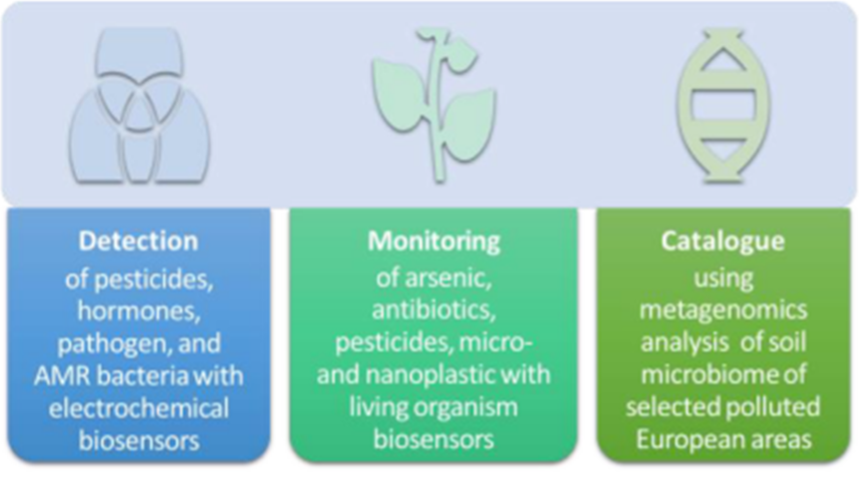Currently, there are no validated portable tests or biosensors for air, soil or water quality control of pathogens, emerging chemicals (CECs) and persistent mobile chemicals (PMCs). Therefore, such devices are eagerly awaited by all stakeholders to ensure successful control and prevention of contamination and infection. The MOBILES consortium will develop an interdisciplinary framework of expertise and tools to monitor, detect and consequently contain pollution from pathogens, CECs and PMCs, thus benefiting human and environmental health.
The MOBILES consortium will work to achieve the following objectives:
- Develop electronic biosensors to monitor organic chemicals (pesticides, hormones) and antimicrobial resistance bacteria and pathogens in water, soil and air;
- Development of an organism-based biosensor for the detection of organic and inorganic pollution in water and soil;
- Investigating the environmental performance of engineered organisms and devices;
- Metagenomic analysis of organisms leaving polluted areas to enable the search for different functionalities across multiple gene clusters.
Conduct safety testing (e.g. EFSA) to assess the impact of engineered organisms on the natural environment. The organism-based biosensors will consist of genetically engineered chemiluminescent bacteria capable of detecting antibiotics, heavy metals and pesticides in water; genetically engineered plants that change color when arsenic is present in soil; and marine diatoms to be used to detect bioplastic degradation in marine and aquatic environments. Developed devices and organisms will be implemented through the use of flexible technologies that can ensure easy adaptation to other biotic and abiotic pollutants. Devices and organisms, once properly validated and approved, could be used by consumers, inspection services and industry operators as well as environmental emergency responders to monitor and detect PMCs, CECs and pathogens in water, air and soil.
Currently there are no portable test or biosensors validated for air, soil or water quality control for pathogens, Chemicals of Emerging Concern (CECs) and Persistent Mobile Chemicals (PMCs), so such devices are much awaited by all stakeholders to ensure successful control and prevention of contamination and infections. Mobiles consortium will develop an interdisciplinary framework of expertise, and tools for monitoring, detection, and consequently mitigation of pollution from pathogens, CECs, PMCs, thus benefiting human and environmental health. Mobiles consortium will work to achieve the following objectives: Develop electronic biosensors for monitoring organic chemicals (pesticides, hormones) and antimicrobial resistance bacteria and pathogens in water, soil and air; Develop organism-based biosensor for detection of organic and inorganic pollution in water and soil; Study environmental performance of developed organisms and devices; Metagenomics analysis of organisms leaving in polluted areas in order to enable searches for diverse functionalities across multiple gene clusters Perform safety tests (e.g., EFSA) to assess the impact of developed organisms on the natural environment. Organism-based biosensor will consist on genetically modified chemiluminescent bacteria able to detect antibiotics, heavy metals, and pesticides in water; genetically modified plants that will change color when in the soil is present arsenic; and marine diatoms that will be used to detect bioplastic degradation in marine and aquatic environments. Developed devices and organisms will be implemented by using flexible technologies, which can guarantee an easy adaptation to other biotic and abiotic pollutants. Devices and organisms, after proper validation and approval, could be used by consumers, inspection services and industry operators, as well as environmental emergency responders to monitor and detect PMCs, CECs and pathogens in water, air and soil.
